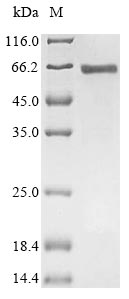The expression region of this recombinant Human SRF covers amino acids 1-508. The theoretical molecular weight of the SRF protein is 53.6 kDa. Expression of this SRF protein is conducted in yeast. The SRF gene fragment has been modified by fusing the N-terminal 6xHis tag, providing convenience in detecting and purifying the recombinant SRF protein during the following stages.
The human serum response factor (SRF) is a transcription factor that regulates the expression of genes involved in various cellular processes, including cell growth, differentiation, and response to extracellular signals, by binding to specific DNA sequences known as serum response elements (SREs). SRF is also a key player in controlling actin cytoskeleton dynamics. It interacts with cofactors, such as myocardin-related transcription factors (MRTFs), to modulate the expression of genes involved in actin polymerization and cellular motility. SRF is essential for the regulation of cell proliferation and differentiation in various tissues and cell types, including muscle cells, neurons, and fibroblasts. SRF is critical for embryonic development and tissue morphogenesis. It is involved in the formation of various organs and tissues during development. Dysregulation of SRF is associated with various diseases, including cancer and cardiovascular disorders. Research on SRF spans molecular and cellular biology, developmental biology, and disease-related studies.




